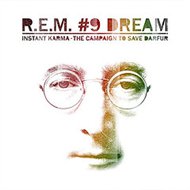
Number 9 Dream

| "#9 Dream" | ||||
|---|---|---|---|---|
 The German single sleeve of the song | ||||
| Single by John Lennon | ||||
| from the album Walls and Bridges | ||||
| B-side | "What You Got" | |||
| Released | 16 December 1974 | |||
| Recorded | July–August 1974 | |||
| Genre | Soft rock | |||
| Length | 4:44 | |||
| Label | Apple | |||
| Songwriter(s) | John Lennon | |||
| Producer(s) | John Lennon | |||
| John Lennon singles chronology | ||||
| ||||
| Walls and Bridges track listing | ||||
12 tracks | ||||
| Official video | ||||
| "#9 Dream" on YouTube | ||||
| "#9 Dream" | ||||
|---|---|---|---|---|
 | ||||
| Single by R.E.M. | ||||
| from the album Instant Karma: The Amnesty International Campaign to Save Darfur | ||||
| Released | May 2007 | |||
| Genre | Alternative rock | |||
| Length | 4:39 | |||
| Label | Warner Bros. | |||
| Songwriter(s) | John Lennon | |||
| R.E.M. singles chronology | ||||
| ||||
"#9 Dream" is a song written by John Lennon and first issued on his 1974 album Walls and Bridges. It was released as the second single from that album months later, on Apple Records catalogue Apple 1878 in the United States and Apple R6003 in the United Kingdom. It peaked at number 9 on the Billboard Hot 100, and it hit number 23 on the British singles chart. A video for the song was made in 2003.[1]

Background
"#9 Dream" came to Lennon in a dream. Lennon has said that the song was just "churned out" with "no inspiration".[2]

That's what I call craftsmanship writing, meaning, you know, I just churned that out. I'm not putting it down, it's just what it is, but I just sat down and wrote it, you know, with no real inspiration, based on a dream I'd had.
— John Lennon, 1980, BBC[2]
According to May Pang's website, two working titles for the song were "So Long Ago" and "Walls & Bridges". Pang also states that the phrase repeated in the chorus, "Ah! böwakawa poussé, poussé", came to Lennon in a dream and has no specific meaning.[3] Pang added that Al Coury of Capitol Records initially protested against the use of the word "pussy" in the chorus, but after Lori Burton, the wife of studio engineer Roy Cicala, suggested that it should be sung as "poussé", as if in a foreign language, the lyrics were kept.[2]

The song was notable as a favourite of Lennon's, despite his later claim that the song was a "throwaway".[2] Pang said on the matter, "This was one of John's favorite songs, because it literally came to him in a dream. He woke up and wrote down those words along with the melody. He had no idea what it meant, but he thought it sounded beautiful."[2]

Content
Lennon liked the string arrangement he wrote for Harry Nilsson's rendition of "Many Rivers to Cross", originally by Jimmy Cliff, from the album Pussy Cats so much that he decided to incorporate it into the song.[2]

The backing vocal is provided by May Pang, Lennon's partner at the time. Lennon wrote and arranged the song around his dream, hence the title and atmospheric, dreamlike feel, including the use of cellos in the chorus. The song's intricate production is reminiscent of "Strawberry Fields Forever".[2]

Recording
The song was tracked at the Record Plant in New York City on 23 July 1974, under the working title "Walls and Bridges". Pang added her dreamy "John" overdub on 26 August 1974.[4]

Reception
It peaked at number 9 on the Billboard Hot 100, also peaking at number 10 on the Cashbox Top 100 in the US.[5] It charted at number 23 on the UK Singles Chart and number 35 in Canada.

Billboard commented on the contrast with Lennon's previous single from Walls and Bridges, "Whatever Gets You Through the Night", stating that "#9 Dream" is a "soft rocker" with "strong production" values which it expected would reach the Top 5.[6] Cash Box said that it "is milder and more gentle than ['Whatever Gets You Through the Night'] with fine and subdued instrumentation acting as mellow cushion to John's vocal" and said that "the lyrics are super."[7] Record World said that Lennon's "best romantic ode since 'Imagine' exits with a chant reminiscent of ex-Beatle Harrison's 'My Sweet Lord.'"[8]

Personnel
The musicians who performed on the original recording were as follows:[9]

- John Lennon – vocals, acoustic guitar
- The 44th Street Fairies: Lennon, May Pang, Lori Burton, Joey Dambra – backing vocals
- Ken Ascher – clavinet
- Jesse Ed Davis – guitar
- Nicky Hopkins – electric piano
- Arthur Jenkins – percussion
- Jim Keltner – drums
- Bobby Keys – saxophone
- Eddie Mottau – acoustic guitar
- Klaus Voormann – bass guitar
Chart performance
Weekly charts
|
Year-end charts
|
Legacy
- R.E.M. covered the song and released it as a single from the 2007 benefit album Instant Karma: The Amnesty International Campaign to Save Darfur. The cover featured founding drummer Bill Berry, his only recording with R.E.M. between his 1997 retirement and the band's 2011 disbandment.[14]
- The international version of the Instant Karma! album features a second cover of the song, by a-ha.[15]
- British novelist David Mitchell titled his second novel number9dream in homage to Lennon.[16]
- Andrea Corr covered this song on her 2011 album, Lifelines.[17]
- Bill Frisell included "Number 9 Dream" on his 2011 Lennon-McCartney tribute album, All We Are Saying.[18]
- José González covered this song on the 2013 film soundtrack for The Secret Life of Walter Mitty.[19]
References
- ^ Kane, Larry (2007). Lennon Revealed (1st pbk. ed. 2007. ed.). Philadelphia, Pa.: Running Press. p. 88. ISBN 9780762434046.
- ^ a b c d e f g "#9 Dream". Beatles Bible. Archived from the original on 18 October 2012. Retrieved 30 October 2014.
- ^ "FAQ | May Pang's Official Website". Maypang.com. 22 February 1999. Archived from the original on 16 January 2010.
- ^ Madinger, Chip; Raile, Scott (2015). LENNONOLOGY Strange Days Indeed - A Scrapbook of Madness. Chesterfield, MO: Open Your Books, LLC. pp. 411, 417. ISBN 978-1-63110-175-5.
- ^ a b Blaney, John (2005). John Lennon: Listen to This Book (illustrated ed.). [S.l.]: Paper Jukebox. p. 326. ISBN 978-0-9544528-1-0.
- ^ "Top Single Picks" (PDF). Billboard. 21 December 1974. p. 69. Retrieved 20 July 2020.
- ^ "CashBox Record Reviews" (PDF). Cash Box. 21 December 1974. p. 24. Retrieved 11 December 2021.
- ^ "Hits of the Week" (PDF). Record World. 21 December 1974. p. 1. Retrieved 13 March 2023.
- ^ Blaney, John (2005). John Lennon: Listen To This Book. Guildford, Great Britain: Biddles Ltd. p. 147. ISBN 0-9544528-1-X.
- ^ "Top RPM Singles: Issue 3937a." RPM. Library and Archives Canada. Retrieved 14 January 2021.
- ^ "Official Singles Chart Top 100". Official Charts Company. Retrieved 14 January 2021.
- ^ Joel Whitburn's Top Pop Singles 1955–1990 – ISBN 0-89820-089-X
- ^ Whitburn, Joel (1999). Pop Annual. Menomonee Falls, Wisconsin: Record Research Inc. ISBN 0-89820-142-X.
- ^ Cohen, Jonathan (12 March 2007). "Original R.E.M. Quartet Covers Lennon For Charity". Billboard. Retrieved 17 May 2008.
- ^ "Instant Karma: The Amnesty International Campaign to Save Darfur - Various Artists - Songs, Reviews, Credits". AllMusic. Retrieved 17 February 2019.
- ^ Mitchell, David (10 March 2001). "I think I'm turning Japanese". The Guardian. Retrieved 14 November 2020.
- ^ Nissim, Mayer (16 March 2011). "Andrea Corr unveils new solo LP, tour". Digital Spy. Retrieved 25 April 2011.
- ^ Steffen Hung (30 September 2011). "Bill Frisell – Number 9 Dream". Australian-charts.com. Retrieved 9 October 2016.
- ^ "José González – "#9 Dream" & "Step Out"". Stereogum. 11 December 2013. Retrieved 9 October 2016.
External links
See what we do next...
OR
By submitting your email or phone number, you're giving mschf permission to send you email and/or recurring marketing texts. Data rates may apply. Text stop to cancel, help for help.
Success: You're subscribed now !

